Ears | Nose | Scales | Eyes | Gills | Swim Bladder | Cold Blooded | Anatomy Chart
Click to see all the types of goldfish
Do They Have Ears and Can They Hear?
Goldfish don’t have external ears but they do have internal ear bone masses called otolith that is suspended above a densely hair-covered macular membrane. These internal ears are more complex than a human ear since sound vibrations in water travel up to five times faster than sound does in air. When sound vibrations travel through the water and hit a goldfish, they are received through the goldfish’s swim bladder and Weberian ossicles. The vibrations then enter the internal ears where the vibrations get deciphered and tell the goldfish where that sound is coming from.
Even though the ear of a goldfish is more complex they do not have the same hearing range as a human. A goldfish can hear 40 to 3,200 Hz and a healthy human can hear 20 to 20,000 Hz. Many goldfish can pick up on the vibrations or music or even the footsteps of a passerby. Tapping on the glass of a goldfish aquarium can be harmful to the health of a goldfish. A goldfish can become stressed out or even die if the vibrations from the tapping are severe enough. Vibrations that enter a goldfish aquarium can bounce off the other sides of the tank, confusing the goldfish. For that reason, goldfish in an aquarium is more sensitive to sound than those in a large pond or stream.
Lateral Line
The lateral line of a goldfish also has the ability to detect vibrations but also senses water currents, pressures, and motion. The lateral line runs along the side of a goldfish’s body, from the head to the caudal tail. This sensory organ is often called a fish’s sixth sense.
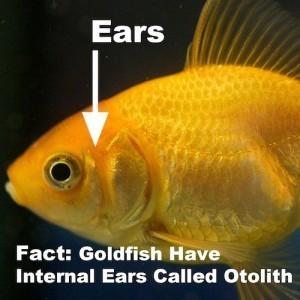
Can It Smell Through its Nose?
A goldfish has a nose located above its mouth but its nares (similar to the nostrils of humans) are not connected to its mouth. Instead, nares are connected to chamber pouches lined with sensory nerve pads. A goldfish can smell various odors and chemicals from substances in the water when raised flaps of skin between each nare channels water into its chamber pouch and passes it over thousands of tiny hairs that make up a sensory pad. A goldfish can distinguish between sweet, sour, savory, and saline smells and the sense of smell in a goldfish is more powerful than humans. There are odors and chemicals that signal for food, chemicals that signal a predator, chemicals that signal when it’s breeding time, or even chemicals that are given off by wounded or alarmed fish.
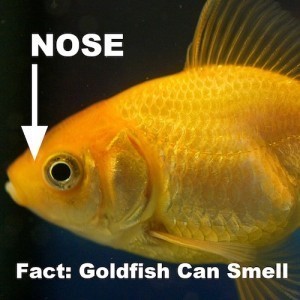
Do Goldfish Scales Grow Back after Injury or Disease?
If a scale is lost due to an illness or injury, it will quickly grow back much like how a fingernail grows back but it will lack these rings.
More about the Scales
A goldfish’s scales are created in the dermis and are bony plates that overlap like the shingles on a roof. As a goldfish grows, its scales grow with it. When the water is warm in the summer months the goldfish grows fast and when the water is cold in the winter months, the goldfish grows slowly. Under the microscope, the goldfish scales of a mature goldfish will have several growth rings. In the summer they grow spread out and in the winter they grow tightly close together. By counting the spread out and tightly compacted groups of rings, one can get the age of a goldfish.
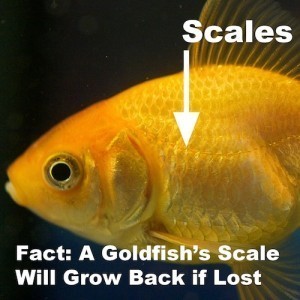
Skin and Slime Coat
Beneath a protective slime coat is the outermost layer of a goldfish called the epidermis. The slime coat layer is produced by the epidermis to help cut down surface tension for mobility in the water and it also acts as a protective barrier to fend off fungus, bacteria, and parasites like Ich. The epidermis is a very thin delicate layer of living skin tissue that covers the scales. The outer layer of skin is so thin that extra precaution should be taken whenever a goldfish is handled; a dry net or hand can easily tear it.
The Coloring
Below the epidermis is the dermis. The dermis is the layer of skin that contains cells that produce the color of a goldfish. There are two types of cells that create color. The first is called chromatophores which produce ‘true’ color patterns from their pigment granules. They are named based on the color that is created by the pigment granules. Expansion and contraction of these pigment granules dictate what color the goldfish is. It’s common for goldfish to be one color and eventually transform into another color. Several factors that can lead to a color change in a goldfish include water temperature, the age of the goldfish, the health, or its diet.
The other type of cells in the dermis is called iridocytes. Iridocytes are cells that act as reflective mirrors and give the goldfish its metallic finish. Silvery guanine in the cells is responsible for their reflective nature. Unlike the chromatophores, the silvery guanine in iridocytes does not expand and contract. It’s the combination of these cells that are responsible for every color and pattern a goldfish might display. These include the metallic, self-colored goldfish with one solid color; a metallic variegated color of two or more colors; and calico colors that are created by three different scale patterns. The three types include the metallic scales that have guanine present; nacreous scales that contain some guanine; and the matt scale type that has no guanine present in the dermis.
What are the Goldfish Body Parts Called?

How Good is a Goldfish’s Eyesight?
A goldfish eye contains rods that are responsible for seeing in low light levels; known as scotopic vision. The goldfish eye also contains cones that are responsible for several things, one of which is seeing in color. A human eye contains three different chemicals that allow it to see colors but a goldfish eye contains those plus another chemical that allows it to see in the ultraviolet spectrum. On top of all of that, a goldfish eye contains a thin coating over it that allows a goldfish to see clearly underwater.
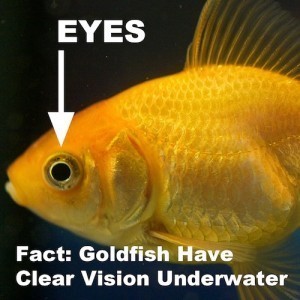
The placement of the eyes on a goldfish limits its ability to see. Not only does the eye placement create a substantial blind spot right in front of the goldfish, but it also makes it harder to see well at greater distances. Certain goldfish breeds have added obstructions that make their vision even worse. The telescope goldfish has its eyes at the ends of the globe like protuberance; the pompon goldfish has exterior nasal septa; the bubble eye goldfish has fluid-filled skin sacks below its eyes; the oranda and ranchu goldfish have a wen hood cover that can cover its eyes; the celestial goldfish has its eyes pointed upwards.
How Do They Breathe Through Their Gills?
A goldfish does need to breathe oxygen but instead of using lungs like mammals, they use a pair of gills. Goldfish gills work much like a pair of lungs but instead use the dissolved oxygen in their water. Since a goldfish lives its entire life in water, it uses osmosis These gills are located right behind the head and eyes on both sides of the goldfish’s body and covered by the operculum, commonly called gill covers. The process of breathing for a goldfish starts when it draws in oxygenated water through its open mouth and closes its throat and operculum.
The goldfish then shuts its mouth and opens its operculum forcing oxygenated water out through the gills. Before the oxygen in the water can enter the goldfish’s bloodstream, it must pass over important parts of the gills. The oxygenated water will first get filtered when it hits the gill rakers. The gill rakers catch free-floating food particles and other waste materials. They act much like the hairs inside your nose do to filter out dust and debris.
After the gill rakers, the water passes through the gill arches and then over the gill filaments. The gill filaments contain two rows of a series of thin membranes called lamellae. The filaments that contain the disc-like lamellae are set up to create a large surface area in a small space. This allows for a maximum amount of gasses to be exchanged; up to 85% of all the oxygen in the water is taken in when it passes over the gills.
Oxygenated water that passes over the lamellae permeates into the goldfish’s bloodstream through the tiny capillaries in the lamellae. This is a similar process that occurs in the lungs of mammals when oxygen gets absorbed through the capillaries in the alveoli that are set up to have a large surface area in a small space. At these capillaries, clean oxygen enters the goldfish’s bloodstream while the byproduct, (deoxygenated) carbon dioxide exits and is forced out into the water through the gill covers.
Note: Colder water contains more oxygenated water than warm water. By keeping a goldfish’s tank water cooler than 70*F, oxygen levels will be elevated, making it easier for goldfish to breathe.
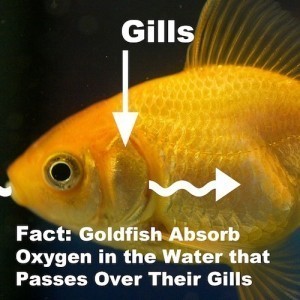
What is a Swim Bladder For?
A goldfish’s swim bladder consists of two small gas-filled sacs located near its dorsal region. The gas-filled sacs of the swim bladder have the ability to expand and contract from the ambient pressure of the surrounding water. The swim bladder sac material contains crystal guanine making it impermeable to gasses. A goldfish can add or subtract air into its swim bladder through its gas gland. By creating lactic acid and carbon dioxide, the hemoglobin of goldfish’s blood loses oxygen and some of that oxygen is diffused into the swim bladder. Through what is called the oval window, these gases can also be diffused back into the bloodstream.
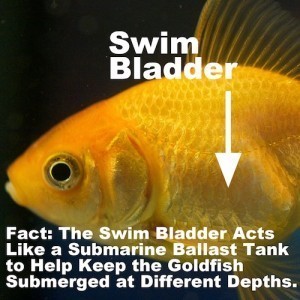
Function of a Swim Bladder
The swim bladder in a goldfish work similarly to a ballast tank in a submarine does. By adding or subtracting air in the swim bladder, the buoyancy of the goldfish allows it to sit submerged at a certain depth without an extra effort. The location of the swim bladder in the dorsal region gives the goldfish lateral stability and keeps it from rolling over upside down. Not only does it help with the buoyancy and stability of the goldfish, but it also assists in its sense of hearing.
Are Goldfish Cold Blooded?
Goldfish, like most fish species, are cold-blooded. Unlike a warm-blooded animal that uses homeostasis to keep its internal body temperature constant, the body temperature of a cold-blooded goldfish is regulated by external environmental factors. When a cold-blooded amphibian-like a pond turtle is cold, it will seek out a nice place to sunbathe to warm its body temperature. Goldfish don’t have the luxury of getting out of the cold water to warm themselves up; instead, a goldfish simply slows down.
This is most noticeable In a goldfish pond during winter when the water temperature drops to 50*F (10*C) or below. Goldfish become less active, sit at the bottom of the goldfish pond, and eat very little. At 40*F (5*C) goldfish go into a semi-hibernation and don’t eat at all. There is little they can do to raise their internal body temperature other than sitting at the bottom where the water temperature is slightly warmer or seek out any pond heaters to sit next to. The main difference between being cold-blooded or warm-blooded is that warm-blooded animals use a lot of their intake of calories to warm their bodies while cold-blooded animals don’t have to.
Warm-blooded animals need to eat 3-4 times as much as cold-blooded animals. A cold-blooded goldfish can go a week or more without eating and not die from starvation. The goldfish will not look emaciated or show signs of malnutrition but it will be hungry. While warm-blooded animals would waste away and die, a goldfish will just stop growing during extended periods of not eating. As soon as the food is reintroduced, the goldfish will resume growing. This makes it okay to err on the side of underfeeding a goldfish as overfeeding is more harmful to a goldfish.
Back to Top
photo credits: Andrew
Reviewed By: Tim Winter

Tim Winter has a strong affection for pets and wildlife. His years of experience caring for various types of pets has led him to share his knowledge with others on the best practices in pet care. Tim holds a Bachelor of Science from the University of Oregon School of Journalism and Communications.

Do goldfish have cells in there scales?
My fish is at a same place for an hour now and it is not moving
It’s gills and expanding and co tracting and mouth is moving
Is it dying?
How do i know what is happening?
If it’s upright it’s probably sleeping, but if not it’s probably sick
How many gills does a goldfish have???
fish are weird but haha no. this didnt help at all. i am looking for pictures of goldfish tissue made of cells.
My goldfish is swimming backwards is that normal??
probs not
Thanks! big help for my science fair project!
My goldfish list its black pupil from its eyes but its looking healthy. Will it regrow back???
Lost its eye pupil the black part…